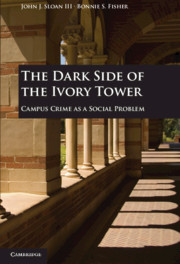Book contents
- Frontmatter
- Contents
- Preface
- Acknowledgments
- The Dark Side of The Ivory Tower
- Chapter One Violence, Vice, and Victimization on American College and University Campuses
- Chapter Two Constructing Campus Crime as a New Social Problem
- Chapter Three Constructing Unsafe and Violent College Campuses
- Chapter Four Constructing the Sexual Victimization of College Women on Campus
- Chapter Five Constructing Postsecondary Institutional Liability for Campus Crime
- Chapter Six Constructing Binge Drinking on College Campuses
- Chapter Seven The Legacy of Claimsmakers
- Index
- References
Chapter Five - Constructing Postsecondary Institutional Liability for Campus Crime
Published online by Cambridge University Press: 05 June 2012
- Frontmatter
- Contents
- Preface
- Acknowledgments
- The Dark Side of The Ivory Tower
- Chapter One Violence, Vice, and Victimization on American College and University Campuses
- Chapter Two Constructing Campus Crime as a New Social Problem
- Chapter Three Constructing Unsafe and Violent College Campuses
- Chapter Four Constructing the Sexual Victimization of College Women on Campus
- Chapter Five Constructing Postsecondary Institutional Liability for Campus Crime
- Chapter Six Constructing Binge Drinking on College Campuses
- Chapter Seven The Legacy of Claimsmakers
- Index
- References
Summary
On the one hand, we have a very tight regulatory environment and horrific liability exposures today. On the other hand, we have security folks, accustomed to compartmentalized jobs, who now find themselves on the front lines. Anything that happens on campus – from date rape, to murder, to IT encroachments – lands at their feet.
Call it what you will, as long as you make it a priority on your campus.
American colleges and universities have evolved into such complex organizations that it is not unusual for them to resemble small cities. To illustrate, college campuses occupy physical space, in some cases several square miles, and often possess lines of demarcation (e.g., gates and fences or green space) that separate them from adjacent spaces. Colleges and universities provide housing to hundreds – perhaps even thousands – of young people in dormitories and on-campus apartments, and many of them are living away from their families for the first time. Thousands of people may be drawn to postsecondary institutions as visitors and because of the employment opportunities they offer. Colleges and universities are also home to many entertainment options, including cultural events such as concerts or musical performances; artistic readings and lectures; and seasonal athletic competitions, which sometimes occur before 100,000 or more people gathered in large stadiums. College and university campuses commonly offer physical fitness facilities and may provide dental, optical, mental health, and medical services to countless students, visitors, and patients. Indeed, in some instances a college campus may house a major medical center, which could include one or more hospitals, numerous clinics, and even high-level research laboratories devoted to solving the problems of emerging diseases.
As colleges and universities grew in size and mission, their daily operations became increasingly more complex. This growth resulted in their safety and security needs also becoming more pressing and more complicated. As is the case with their city counterparts, colleges and universities have to provide a range of safety and security measures for students, staff, and visitors to help prevent and respond to not only criminal events but those events involving natural or man-made disasters, such as toxic spills and fires.
- Type
- Chapter
- Information
- The Dark Side of the Ivory TowerCampus Crime as a Social Problem, pp. 111 - 138Publisher: Cambridge University PressPrint publication year: 2010



